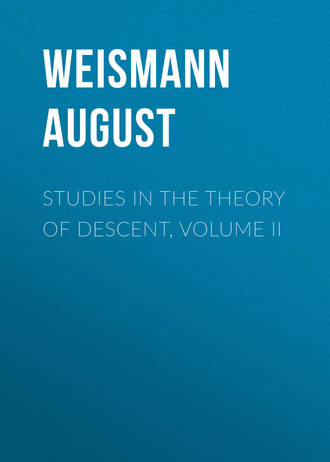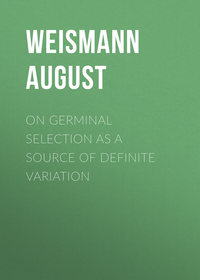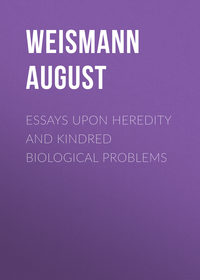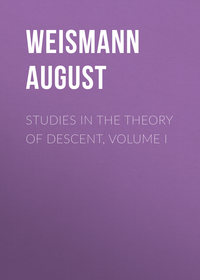 полная версия
полная версияStudies in the Theory of Descent, Volume II

August Weismann
Studies in the Theory of Descent, Volume II
I. Larva and Imago vary in Structure independently of each other
It would be meaningless to assert that the two stages above mentioned were completely independent of one another. It is obvious that the amount of organic and living matter contained in the caterpillar determines the size of the butterfly, and that the quantity of organic matter in the egg must determine the size of the emergent larva. The assertion in the above heading refers only to the structure; but even for this it cannot be taken as signifying an absolute, but only a relative independence, which, however, certainly obtains in a very high degree. Although it is conceivable that every change of structure in the imago may entail a correlative change of structure in the larva, no such cases have as yet been proved; on the contrary, all facts indicate an almost complete independence of the two stages. It is quite different with cases of indirect dependence, such, for example, as are brought about by ‘nurse-breeding.’ This phenomenon is almost completely absent in Lepidoptera, but is found in Diptera, and especially in Hymenoptera in every degree. The larvæ of ichneumons which live in other insects, require (not always, but in most instances) that the female imago should possess a sharp ovipositor, so that in this case also the structure and mode of life of the larva influences the perfect insect. This does not depend, however, on inherent laws of growth (correlation), but on the action of external influences, to which the organism endeavours to adapt itself by natural selection.
I will now let the facts speak for themselves.
It is shown by those species in which only one stage is di- or polymorphic that not every change in the one stage entails a corresponding change in the other. Thus, in all seasonally dimorphic species we find that the caterpillars of butterflies which are often widely different in the colour and marking of their successive generations are absolutely identical. On the other hand, many species can be adduced of which the larvæ are dimorphic whilst the imagines occur only in one form (compare the first and second essays in this volume).
There are however facts which directly prove that any one stage can change independently of the others; I refer to the circumstance that any one stage may become independently variable – that the property of greater variability or of greater constancy by no means always occurs in an equal degree in all the three stages of larva, pupa, and imago, but that sometimes the caterpillar is very variable and the pupa and imago quite constant. On the other hand, all three stages may be equally variable or equally constant, although this seldom occurs.
If variability is to be understood as indicating the period of re-modelling of a living form, whether in its totality or only in single characters or groups of characters, from the simple fact of the heterochronic variability of the ontogenetic stages, it follows that the latter can be modified individually, and that the re-modelling of one stage by no means necessarily entails that of the others. It cannot however be doubted that variability, from whatever cause it may have arisen, is in all cases competent to produce a new form. From the continued crossing of variable individuals alone, an equalization of differences must at length take place, and with this a new, although not always a widely deviating, constant form must arise.
That the different stages of development of a species may actually be partly variable and partly constant, and that the variable or constant character of one stage has no influence on the other stages, is shown by the following cases, which are, at the same time, well adapted to throw light on the causes of variability, and are thus calculated to contribute towards the solution of the main problem with which this investigation is concerned.
When, in the following pages, I speak of variability, I do not refer to the occurrence of local varieties, or to variations which occur in the course of time, but I mean a high degree of individual variability – a considerable fluctuation of characters in the individuals of one and the same district or of the same brood. I consider a species to be constant, on the other hand, when the individuals from a small or large district differ from one another only to a very slight extent. Constant forms are likewise generally, but not invariably, such as are poor in local varieties, whilst variable forms are those which are rich in such variations. Since the terms “variable” and “constant” are but relative, I will confine myself to the most extreme cases, those in which the individual peculiarities fluctuate within very wide or very narrow limits.
As no observations upon the degree of variability shown by a species in the different stages of its development were available, I was obliged to fall back upon my own, at least so far as relates to the larval and pupal stages, whilst for the imaginal stage the wide experience of my esteemed friend Dr. Staudinger has been of essential service to me.
Let us in the first place confine our attention to the three chief forms which every Lepidopteron presents, viz. larva, pupa, and imago. With respect to the constancy or variability of these three forms, we actually find in nature all the combinations which are theoretically conceivable.
(1.) There are species which possess a high degree of constancy in all three stages, such, for example, as Limenitis Camilla, Pieris Brassicæ,1 Sphinx Ligustri, and Euchelia Jacobææ.
(2.) There are species showing a high degree of variability in all three stages. This case must be of rare occurrence, as I am only able to adduce Araschnia Prorsa-Levana, a fact which arises from the circumstance that the pupal stage is, as a rule, but seldom variable.
(3.) There are species which are variable in two stages and constant in the third. To this class, for example, belongs Smerinthus Tiliæ, of which the larva and imago are very variable, whilst the pupa is quite constant. The same is the case with Lasiocampa Pini, the well-known fir moth. Many butterflies show this same phenomenon in other combinations, such, for instance, as Vanessa Urticæ and Polychloros, in which the larva and pupa are very variable, and the imago very constant. In a less degree the same is also the case with Vanessa Atalanta, whilst in Pieris Napi the pupa and imago are variable, and the caterpillar remarkably constant, this likewise being the case with the local form Bryoniæ, which, according to my theory, is to be regarded as the parent form of Napi (See Part I. of the present volume).
(4.) There are species which are constant in two stages, and variable only in the third. Thus, a few species can be found in which the larva and pupa are constant and the imago variable. This is the case with Saturnia Yamamai, the imago of which is well known to present numberless shades of colour, varying from light yellow to greyish black, whilst the green caterpillar shows only slight individual differences of marking, and scarcely any differences of colour. The pupa of this species is quite constant. Arctia Caja and Hebe, and Chelonia Plantaginis belong to this same category.
There are a very large number of species which possess very constant imagines and pupæ, but extremely variable larvæ. The following are the cases known to me: —Macroglossa Stellatarum, Fuciformis and Bombyliformis; Chærocampa Elpenor, Celerio, and Nerii; Deilephila Galii, Livornica, Hübn., Hippophaës, Vespertilio, and Zygophylli; Sphinx Convolvuli; Acherontia Atropos; Smerinthus Ocellatus and Tiliæ; Callimorpha Hera; Cucullia Verbasci and Scrophulariæ.
Cases in which the variability depends entirely upon the pupa, while the larva and imago are extremely constant, are of great rarity. Vanessa Io is a case in point, the pupa being light or dark brown, or bright golden green, whilst in the two other stages scarcely any light shades of colour or variations in the very complicated marking are to be met with.
The facts thus justify the above view that the individual stages of development change independently – that a change occurring in one stage is without influence on the preceding and succeeding stages. Were this not the case no one stage could possibly become variable without all the other stages becoming so. Did there exist a correlation between larvæ, pupæ, and imagines of such a nature that every change in the larva entailed a corresponding change in the imago, as soon as a large number of larval characters became fluctuating (i. e. as soon as this stage became variable), a large number of imaginal characters would necessarily also become fluctuating (i. e. this stage would also become correspondingly variable).
There is one other interpretation which might perhaps be attempted from the point of view of the old doctrine of species. It might be said that it is a special property of certain larval or imaginal markings to be variable whilst others are constant, and since the larval and imaginal markings of a species are generally quite distinct, it may easily happen that a butterfly possessing markings having the property of constancy may belong to a caterpillar having variable markings.
There is a soul of truth underlying this objection, since it is true that the various forms of markings which occur in Lepidoptera apparently reach different degrees of constancy. If we speak of the constancy or variability of a species, a different meaning is attached to these expressions according as we are dealing e. g. with a species of Sphinx or a species of Arctia. That which in the latter would be estimated as a high degree of constancy, in the former would be taken as a considerable amount of variability. It is of interest, in connection with the question as to the causes of constancy, to note that the power of any form of marking to attain to a high degree of constancy is by no means inversely proportional to the complication of the marking, as would have been expected à priori.
Thus, the species of Sphinx and of allied genera possess on their fore-wings, which are mostly coloured with a mixture of dull grey, white and black, an exceedingly complicated arrangement of lines which, in constant species, show a high degree of uniformity: on the other hand, the checquered fore-wings of our Arctiidæ, which are far more coarsely marked, always show, even in the most constant species, well-marked individual differences. The different types of marking must therefore be measured by different standards.
But in granting this, we decidedly refute the statement that constancy and variability are inherent properties of certain forms of marking.
This reasoning is based on the simple fact that a given type of marking comprises both species of great constancy and of (relatively) great variability.
Thus, the fore-wings of Sphinx Ligustri and S. Convolvuli are extremely constant, whilst the very similarly marked Anceryx (Hyloicus) Pinastri is exceedingly variable. Similarly Deilephila Euphorbiæ is known by its great variability of colouring and marking, whilst D. Galii, which resembles this species so closely as to be sometimes confounded with it, possesses a high degree of constancy, and further, the Corsican and Sardinian D. Dahlii is very variable. Among the family Arctiidæ, Callimorpha Hera and the Alpine Arctia Flavia are cases of constancy, whilst A. Caja, which is so similar to the last species, is so generally variable that two perfectly identical specimens can scarcely be found together.
The same can be shown to hold good for the markings of caterpillars. Thus, the larva of D. Dahlii shows very considerable variability, whilst that of D. Galii is very constant in marking (disregarding the ground-colour). So also the larva of Vanessa Urticæ is very variable and that of V. Antiopa very constant, &c.
The great differences with respect to constancy or variability which are displayed by the different stages of one and the same species, must therefore find their explanation elsewhere than in the type of the marking itself. The explanation must be found in the circumstance that each stage changes independently of the others, and at different periods can enter a new phase of variability.
We are here led in anticipation to the main question: – Are changes produced by internal or external causes? is it the physical nature of the organism which is compelled to become remoulded spontaneously after the lapse of a certain period of time? or does such modification only occur when produced directly or indirectly by the external conditions of life?
In the cases before us the facts undoubtedly indicate a complete dependence of the transformations upon external conditions of life.
The independent appearance of variability in the separate stages of the metamorphosis might, however, be regarded as only apparent. It might still be attempted to attribute the changes to a purely inherent cause, i. e., to a phyletic vital force, by assuming that the latter acts periodically in such a manner that at first one and then the following stage becomes variable, until finally the entire species is transformed.
There is but little to be said in reply to this if we once take refuge in entirely unknown forces, the operation of which can be arbitrarily conceived to be either constant or periodic.
But granting that such a transforming power exists and acts periodically, the variability must always pass over the different stages in a fixed direction, like a wave over the surface of water – imago, pupa, and larva, or larva, pupa, and imago, must successively become variable. Cases like that of Araschnia Prorsa, in which all three stages are variable, may certainly be thus explained, but those instances in which the larva and imago are extremely variable, and the pupa quite constant, are entirely inexplicable from this point of view.
The latter can, however, be very simply explained if we suppose the changes to be dependent upon external influences. From this standpoint we not only see how it is possible that an intermediate stage should remain uninfluenced by the changes which affect the two other stages, but we can also understand why it should just be the pupal stage that plays this part so frequently. If we ask why most pupæ are constant and are relatively but very slightly variable, the answer will be found in the facts that all pupæ which remain concealed in the earth or inside plants (Sesiidæ), or which are protected by stout cocoons, show complete constancy, whilst any considerable amount of variability occurs only in those pupæ which are suspended or openly exposed. This is closely connected with a fact to which I have called attention on a former occasion,2 viz., that dimorphism occurs in certain pupæ, but only in those which are openly exposed and which are therefore visible to their foes. I am only acquainted with such cases among the pupæ of butterflies, and it is likewise only among these that I have found any considerable amount of variability.
Facts of this kind indicate that Nature does not uselessly sport with forms, but that at any rate changes of this sort result from external influences. The greater frequency of variability among larvæ and its comparative rarity in imagines is also undoubtedly in favour of this view.
It has already been shown that species with variable larvæ and constant imagines are extremely common, but that those with constant larvæ and variable imagines are very rare. This confirms the conclusions, already drawn above, first, that the variability of the imago cannot owe its existence to the variability of the larvæ, and secondly, that the causes which produce variability affect the larval condition more commonly than that of the imago.
Where can these causes be otherwise sought than in the external conditions of life, which are so widely different in the two stages, and which are much more variable for the larva than for the imago?
Let us take the species of one genus, e. g. those of Deilephila. The imagines of our European species – as far as we know – all live in precisely the same manner; they all fly at twilight,3 showing a preference for the same flowers and very often frequenting the same spots, so that in the haunts of one species the others are almost always to be met with, supposing them to occur in the same locality. They conceal themselves by day in similar places, and are attacked by similar foes.
It is quite different with the caterpillars. These, even in the case of the most closely allied species, live under different conditions, as appears from the fact that they feed on different plants. The latter can, however, produce changes both directly and indirectly. The larvæ may acquire adaptive colours and markings, and these would vary in accordance with the colour and structure of the food-plant; or they may become brightly coloured as a sign of distastefulness in cases where they are inedible. Then again the colour of the soil on which the larvæ live would act upon their colours making these adaptive. Certain habits of the caterpillars may also be dependent upon the nature of their food-plants. Thus, e. g. Deilephila Hippophaës feeds only at night, and conceals itself by day under moss and among the leaves at the base of the food-plant; but D. Euphorbiæ could not acquire such a habit, because Euphorbia Cyparissias generally grows on arid soil which is poor in vegetation, and which therefore affords no concealment, and furthermore, because a caterpillar, as long as it continues to feed, cannot, and as a matter of fact does not, ever wander far from its food-plant. A habit of concealment by burying in the earth also, such for example as occurs in Acherontia Atropos, could not be acquired by D. Euphorbiæ, because its food-plant generally grows on hard, dry, and stony ground.
In addition to these considerations, the foes would be different according as the caterpillar lived on plants which formed dense thickets covering large extents of the shore (Hippophae) or grew isolated on dry hillocks and declivities where the herbage was scanty or altogether absent; or again, according as the insect, in conjunction with such local differences, fed by day or had acquired the habit of feeding only by night. It must in fact be admitted that new and improved adaptations, or, in more general terms, that inducements to change, when depending on the environment, must be more frequently dissimilar for larvæ than for the imagines. We must accordingly expect to find actual change, or that condition of variability which may be regarded as initiative to change, occurring more commonly in larvæ than in perfect insects.
Since facts are in complete accordance with the results of these à priori considerations we may also venture to conclude that the basis of the considerations is likewise correct, viz., the supposition that the changes of colour and marking in caterpillars, pupæ, and imagines result from external influences only.
This must not be taken as signifying that the single stages of the larval development are also only able to change through the action of external influences. The larval stages are correlated with each other, as has already been shown (see the previous essay): new characters arise in the adult caterpillar at the last stage and are then gradually transferred back to the younger stages quite independently of external influences, this recession being entirely brought about by the laws of correlation. Natural selection here only exerts a secondary action, since it can accelerate or retard this transference, according as the new characters are advantageous or disadvantageous to the younger stages.
Now as considerable individual differences appear in the first acquisition of a new character with respect to the rapidity and completeness with which the individuals acquire such a character, the same must obtain for the transference of an improvement acquired in the last stage to the next younger stage. The new character would be acquired by different individuals in different degrees and at different rates – it would have, to a certain extent, to struggle with the older characters of the stage; in brief, the younger stage would become variable.
Variability of this kind might well be designated as secondary, in contradistinction to primary variability; the latter (primary) depends upon an unequal reaction of the individual organisms to external influences, the former (secondary) results from the unequal strength and rate of the action of the innate laws of growth governing the organism. In both cases alike exceeding variability may occur, but the causes producing this variability are dissimilar.
The different stages of larval development would thus frequently display independent variability in a manner similar to the pupal or imaginal stages, since they can show individual variability while the other stages of development remain constant. This appearance of independent variability in the different stages of the larval development, however, is in truth deceptive – we have here in fact a kind of wave of variability, which passes downwards through the developmental stages, becoming gradually weaker, and finally dying out completely.
In accordance with this, we very frequently find that only the last or two last stages are variable, while the younger stages are constant. Thus in Macroglossa Stellatarum, the larvæ are constant in the first, second, and third stages, but become variable in the fourth, and in the fifth stage first show that high degree of variability which has already been described in detail (See. Pl. III., Figs. 3–12). The larvæ, of Vanessa Cardui also, according to my notes, are extremely constant in the first four stages in spite of their complicated marking, but become variable in the fifth stage, although to no very great extent.
In Smerinthus Tiliæ, Ocellatus and Populi also, the greatest larval variability is shown only in the last stage, the preceding stages being very constant. These cases by no means depend upon the marking of the young stages being simpler and therefore being less capable of varying. The reverse case also occurs. In a somewhat similar manner as the young of the tapir and wild hog are striped, while the adult animals are plainly coloured, the young caterpillars of Saturnia Yamamai possess longitudinal black lines on a yellow ground, while as early as in the second stage a simple green colour appears in the place of this complicated but perfectly constant marking. If the young stages are so frequently constant, this rather depends upon the fact that the transference of a new character to these stages not only takes place gradually, but also with continually diminishing energy, in a manner somewhat similar to physical motion, which continually diminishes in speed by the action of resistance till it is completely arrested. This constancy of the younger stages may further be due to the circumstance that the characters would only be transferred when they had become fixed in the last stage, and were consequently no longer variable. The transferred characters may thus have acquired a greater regularity, i. e. a less degree of variability, than they possessed at their first origination. Extensive investigations in this special direction must be made if the precise laws, in accordance with which the backward transference of new characters takes place, are to be discovered. By such researches only should we arrive with certainty at the causes which determine the lesser variability of the young larval stages.
It may also occur that the early stages are variable, whilst the later stages are constant, although this case appears to happen less frequently. Thus, the caterpillars of Gastropacha Quercifolia vary considerably in the second stage but are constant at a later period, and the same is the case with Spilosoma Urticæ, which in the second stage may be almost considered to be dimorphic, but which subsequently becomes constant.






